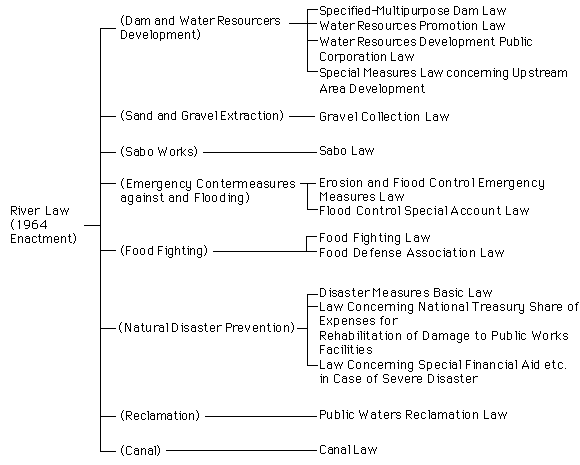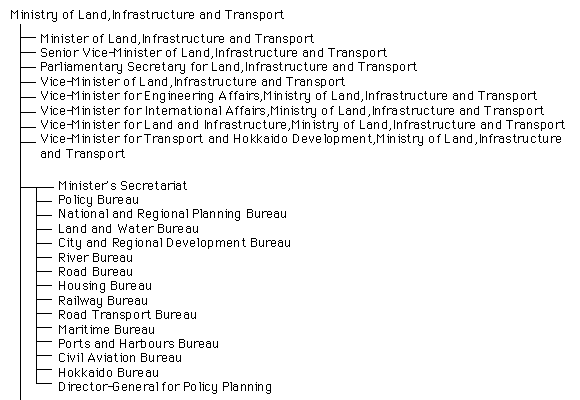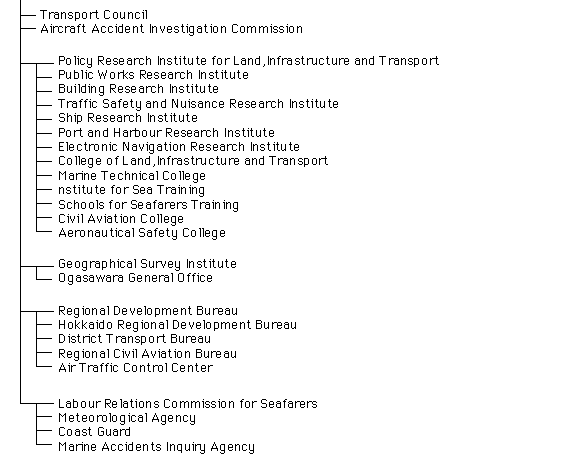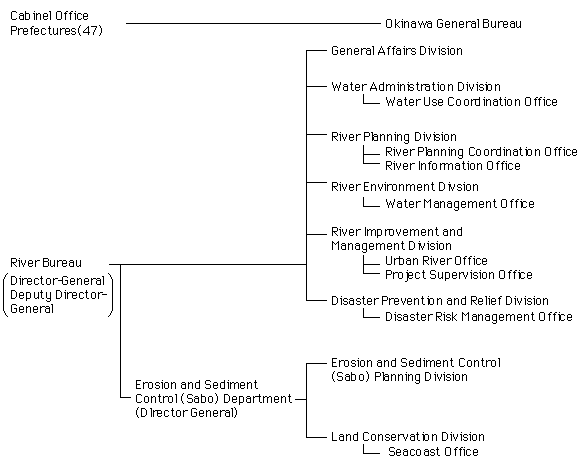The River Bureau plans and implements a variety of projects to protect people from disasters caused by rivers, sediment, storm surge, and other natural phenomena, and to ensure sufficient water resources to support affluent lifestyles and develop attractive waterside environments.
The River Bureau also drafts laws, manages river administration, issues licenses for water use, and maintains facilities for the proper management of rivers, sediment control, and coastal protection.
- River Administration Classification
Two main objectives have motivated river administration in Japan since early times.One is to control river flooding and the other is to ensure availability of river water for daily and industril use.
Recently, conservation and creation of river environments have become increasingly important aspects of river administration.
In accordance with the River Law, river administration is done by classifying rivers, breaking them into sections, and delegating responsibility for the administration of their various subdivisions. River systems deemed important for the national economy and people's lives are designated as "Class A river systems" and administrated by the Minister of Construction.The others are designated as "Class B river systems" and administrated by the prefectural governors.
Class A river systems are further sub-classified as"Trunk rivers" and "Others"; and the "Others" are administered, except for approval of certain specified water rights, by the prefectural governors.
Some sections of small tributaries of both class A and class B rivers, where part of the River Law is applied are set. Administration of the others is done by the mayors of cities, towns, and villages.
Other smaller rivers not mentioned above, to which the River Law is not applied at all, are administered by mayors.
The River Law stipulates that any utilization of land and river water within the sections defined by the River Law must obtain approval from the designated river administrator.
The total length of class A rivers, which include 109 river systems, is approximately 87,150 km; the length of class B rivers, which include 2,691 river systems, totals approximately 35,720 km; and the total length of rivers to which the River Law is applied was approximately 132,870 km as of June, 1993.
TableNumber of Rivers (June, 1993)
|
River
systems
|
Rivers |
Total length
(km)
|
Total catchment
area (km2)
|
Class A rivers
Class B rivers
|
109
2,691
|
13,798
6,931
|
87,152.5
35,717
|
239,947
107,997
|
- Profile of Related Laws
The objectives of river administration are upgrading of safety of the nation's land against flood disasters, stabilization of the water supply, and improvement of the living environment. River administration centers on the River Law and is also regulated by the Specified-Multipurpose Dam Law, the Sabo Law, and the Seacoast Law.
- Organization
The Ministry of Construction was established, and the River Bureau was provided as its internal bureau for managing various matters related to rivers, by the enactment of the Ministry of Construction Establishment Law on July 1, 1948.
Today, the River Bureau department, comprises ten divisions and five sections involved in river planning, river improvement, dam construction, disaster recovery, sand control measures, and coastal preservation. The Bureau also maintains eight Regional Construction Bureaus - Tohoku, Kanto, Hokuriku, Chubu, Kinki, Chugoku, Shikoku, and Kyushu.
|



